
The Most Revered Hindu Temples of Kashmiri Pandits
The temples of Kashmir Pandits in the enchanting landscapes of Kashmir stand as beacons of spirituality and cultural heritage .These sacred places provide a deep connection with the past and a spiritual sanctuary for devotees Join us as we seek Inside some of the most revered Hindu temples , delving into their historical significance, architectural splendor, and the spiritual journeys they offer. For those planning a trekking or cultural tour, consider checking out this Kashmir itinerary to enhance your experience.






Historical Background of Kashmiri Temple
The historical background of Kashmiri temples is rich and varied, reflecting the diverse ancient and cultural heritage of the region. The Kashmiri temples belong to the earlier centuries of the common period, and some of the earliest buildings are said to date from the reign of the Kushan dynasty. The architectural style of these temples is influenced by indigenous and exotic elements with a mixture of Buddhist, Hindu and later Islamic motifsA notable period in the history of Kashmiri temples is the reign of the Karkota dynasty (7th to 9th century), when major temples were built The Martanda Surya Temple, built by King Lalitaditya Muktapidana in the 8th century, stands as greatness a prime example is the architecture of this period. and structural expression , reflecting a combination of Gandharan, Gupta, local and Kashmiri influences
The Utpala dynasty (9th to 10th century) contributed greatly to the architecture of the temple, constructing notable structures such as the Shankaracharya temple on top of a hill overlooking Srinagar This temple dedicated to Shiva has become a focal point of they are journeys and spiritual realizations.
Many Kashmiri temples have suffered damage due to invasions and natural disasters over the centuries, but they remain symbols of the region’s resilient cultural and spiritual heritage Magnificent calligraphy, ornate iconography and architecture about the unique design of these temples continues to attract historians, archaeological interest and tourists And you get a glimpse of the heritage
Many Kashmiri temples have suffered damage due to invasions and natural disasters over the centuries, but they remain symbols of the region’s resilient cultural and spiritual heritage Magnificent calligraphy, ornate iconography and architecture about the unique design of these temples continues to attract historians, archaeological interest and tourists And you get a glimpse of the heritage




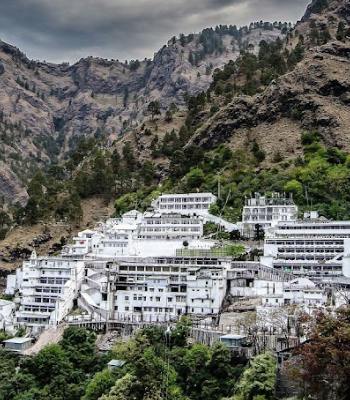

Significance of Temples in Hinduism
Temples occupy an important place in Hinduism, serving as sacred places where devotees can commune with the divine. They are not only places of worship but also cultural centers where ancient traditions and practices are preserved. The deities of the temples have and are designed according to sacred architectural principles, creating a spiritual atmosphere of contemplation and devotion. They play an important role in community life, hosting festivals, rituals and ceremonies that bring people together. Visiting temples is believed to purify the mind and soul, providing spiritual benefits and a deeper relationship with God.1. Shankaracharya Temple
The Shankaracharya Temple on Shankaracharya Hill in Srinagar is one of the most revered Hindu temples for Kashmiri Pandits. The ancient temple dedicated to Lord Shiva is an important spiritual and cultural landmark. Its elevated location offers panoramic views of Dalsarovar and the beautiful Srinagar Valley, making it a peaceful and inspiring destination for trekkers and visitors Built in the 9th century, the Shankaracharya temple has historical and religious significance. It is believed that Adi Shankaracharya, a revered Hindu philosopher and theologian visited the temple and meditated here to enhance its sanctity. The architecture of the temple shows a blend of classical Kashmiri and Hindu architecture, characterized by beautifully carved stone pillars and a holy shrine

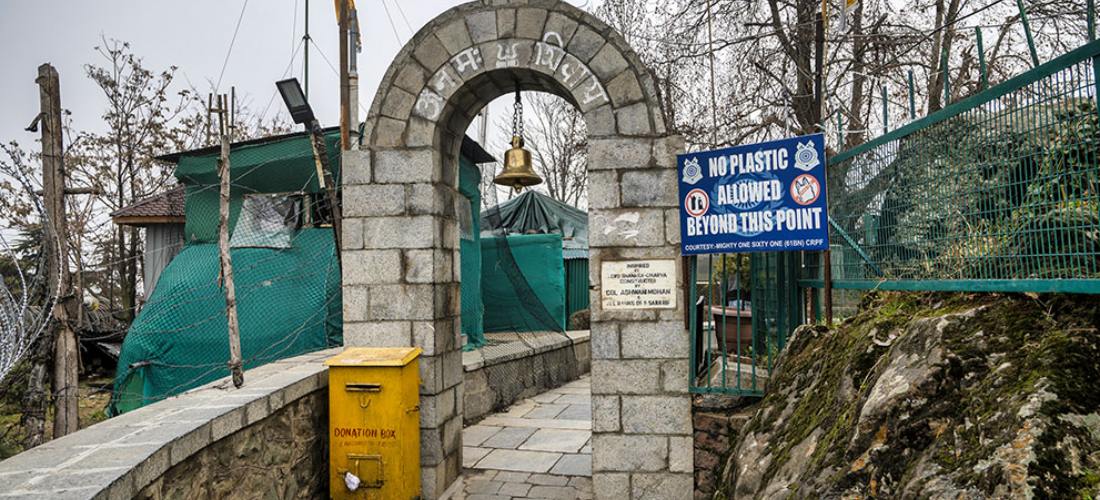

For Kashmiri Pandits, the Shankaracharya temple represents extra than simply an area of worship; It symbolizes their enduring cultural and spiritual heritage. The temple is a main venue for spiritual ceremonies and festivals, attracting devotees from all around the location. Its non secular ecosystem and historical historical past make it an critical area for folks that want to apprehend the deeply rooted subculture of Kashmiri Pandits.
Visitors to the Shankaracharya temple regularly describe the experience as spiritually uplifting and visually beautiful. With sharp steps and breathtaking views, this trek is considered a real trek. The temple offers a unique opportunity to touch the divine even as admiring the natural beauty of Kashmir.
Whether you are a pilgrim saint or an adventurer, the Shankaracharya Temple gives a profound and enriching enjoy. It stands as a testomony to the wealthy cultural material of Kashmir and the unwavering faith of Kashmiri Pandits.
Visitors to the Shankaracharya temple regularly describe the experience as spiritually uplifting and visually beautiful. With sharp steps and breathtaking views, this trek is considered a real trek. The temple offers a unique opportunity to touch the divine even as admiring the natural beauty of Kashmir.
Whether you are a pilgrim saint or an adventurer, the Shankaracharya Temple gives a profound and enriching enjoy. It stands as a testomony to the wealthy cultural material of Kashmir and the unwavering faith of Kashmiri Pandits.
2. Sharda Peeth
Sharda Peeth is an ancient temple and revered learning site located in the Neelum Valley of Pakistan-administered Kashmir. Esteemed as a prime pilgrimage site for Kashmiri Pandits, it bears significant historical and cultural value.



Historical Significance
Sharadapeeth was an important center of scholarship, attracting scholars from the Indian subcontinent and playing an important role in the study of Sanskrit, theology, philosophy and art. Dedicated to Goddess Sharada, the incarnation of Saraswati, the temple is a symbol of knowledge, music, art, wisdom and learning, whose very name derives the name “Sharada” from the Sanskrit word “Saraswati” which established the long-standing importance of that this place is emphasizedCultural and Religious Importance
Sharda Peeth, one of the 18 Maha Shakti Peethas, holds immense religious significance for Kashmiri Pandits as a prominent pilgrimage site. The temple serves as a focal point for various religious activities, particularly during significant Hindu festivals like Navratri, attracting numerous devotees who come to perform rituals and seek blessings.3. Martand Sun Temple
Best Time to Visit: April to OctoberNearest Town: Anantnag (about 9 km away)
Accessibility: Easily reachable by road from Srinagar (about 65 km)
Located in the picturesque Anantnag district of Kashmir, the Martand Sun Temple stands as a testament to the grand architectural legacy of the region. Though now in ruins, this ancient temple continues to captivate visitors with its impressive scale and historical significance.



- Built by: King Lalitaditya Muktapida of the Karkota Dynasty
- Time Period: 8th century CE (around 725-756 CE).
- Dedicated to: Surya, the Sun God.
- Architectural Style: Kashmiri Hindu architecture
A Glimpse into Its Glory
- A main shrine surrounded by 84 smaller shrines
- Massive stone blocks, expertly fitted without mortar
- Intricate carvings and sculptures adorning the walls.
Stunning Location:
- Situated on a plateau overlooking the Kashmir Valley.
- Backdrop of snow-capped Himalayan peaks
- Surrounded by lush meadows and streams
Historical Significance
The Martand Temple is more than just a religious site. It represents:- The zenith of Kashmiri Hindu architecture
- A symbol of Kashmir’s rich cultural heritage
- Evidence of the region’s historical importance in art and spirituality
Current State
Unfortunately, the temple now lies in ruins due to:- Natural weathering over centuries
- Deliberate destruction during invasions
4. Zeashta Devi Shrine
Zeeshta Devi Temple, located in the scenic Srinagar district of Kashmir, is dedicated to Goddess Zeeshta, the incarnation of Goddess Durga. Surrounded by lush vegetation and peaceful landscape, the temple is an important spiritual center for devotees. There is a sacred spring in the temple, which is believed to have healing powers. Ziashta Devi Temple has cultural and religious significance, attracting pilgrims and tourists. Its peaceful atmosphere and spiritual significance make it a must-visit for those seeking peace and divine blessings in the beautiful valley of Kashmir.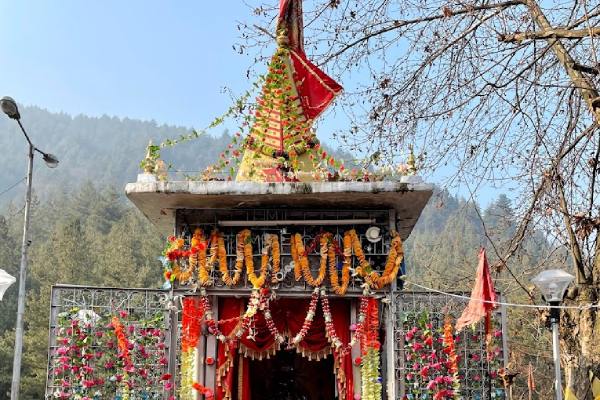



5. Jwala Ji Temple
Jwala Ji Temple, also known as Jwalamukhi Temple, is a Hindu shrine in Khrew, Pulwama district, Jammu and Kashmir, India. Dedicated to the deity Jwala Ji, the Kul Devi of many Kashmiri Hindu families, the temple is a significant spiritual site. Each year in Ashadha, the Jwalamukhi Fair is held here, celebrating the communal harmony of Kashmiriyat with participation from both Kashmiri Hindus and Muslims.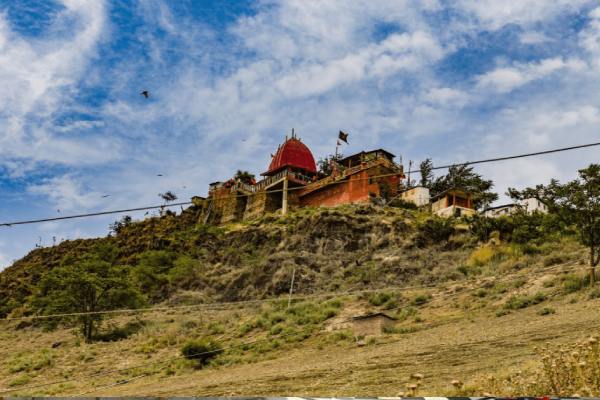


Historian Kalhana mentions Khrew, called “Khaduvi” in the Rajatarangini, noting its 360 freshwater springs and a mystical diagram on a nearby hillside. The temple’s rich history and cultural significance make it a popular pilgrimage and tourist destination. Its serene surroundings and profound spiritual importance offer visitors a unique and peaceful experience in the picturesque valley of Kashmir.
6. Kheer Bhavani
Kheer Bhawani is a temple of goddess Ragnya Devi constructed over a sacred spring in Tula Mula village at a distance of 14 miles east of Srinagar. It has got the term kheer as most of the devotees offer kheer (rice pudding) to goddess, an incarnation of Durga Bhawani. This temple is one of the most revered religious sites for Kashmiri Pandits. The sacred spring is widely known for its mystical power to changes its color. While most of the colors do not have any significance, the black is considered as an inauspicious time for Kashmir. In 1912, Maharaja Pratap Singh constructed the temple and later Maharaja Hari Singh repaired it. Presently, the temple runs under the Dharmath Trust led by Dr. Karan Singh.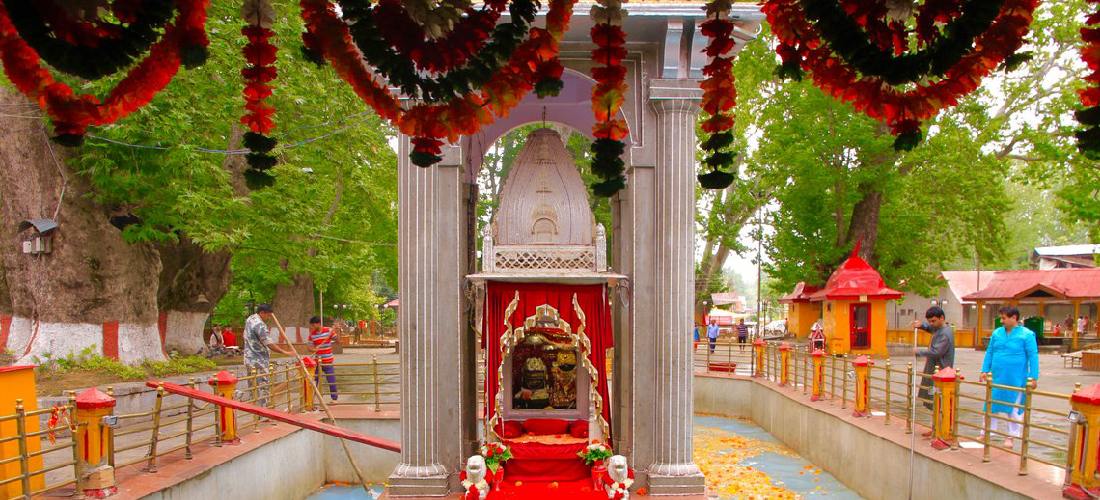
Devotees from far and wide visit the temple to seek blessings of the mother goddess. The eight day of full moon in the month of May is considered to be sacred and also believed that on this day the sacred spring changed its color. An annual mela is also held in the premises of the temple during this period. Pilgrims in huge numbers thronged the temple to celebrate the day.
7. Sharika Devi Temple:
The Sharika Devi Temple is situated on westerns slope of the Hari Parvat in Srinagar. The temple is dedicated to Goddess Jagadamba Sharika Bhagwati, an incarnation of Mata Durga/ Shakti. The idol inside the temple has 18 arms and is regarded as the presiding deity of the Srinagar by Hindu followers. This temple is regarded as one of the most sacred sites by Kashmiri Pandits, this day is celebrated as Har Navum. The shrine is thronged with devotees in large number on the birthday of Sharika Bhagwati. They offer a special offering locally termed as ‘Taher Charvan’ (A dish of boiled rice with turmeric, oil and salt and another dish is of cooked liver of goat) to the goddess.


8. Raghunath Temple:
Raghunath Temple is located right in the center of Jammu City on the bank of River Tawi. The most popular temple of the Jammu region is dedicated to Lord Rama. There are total seven temples in the complex of Raghumath temple, which makes it as the largest temple complex in Northern India. The main idol of deity Rama of the temple was brought from Ayodhya, the birthplace of Rama. There are good numbers of galleries that houses 12,00000 shaligrams, the emblem of Lord Vishnu. This ancient temple was built by Maharaj Gulab Singh, Dogra ruler and completed by his son Maharaj Ranbir Singh. Interior of the temple is embellished with gold plated materials, arts and paintings.
9. Avantipur Temple:
Awantipora, also known as Avantipur, is a town in the Pulwama district of Jammu and Kashmir, India, located on the banks of the Jhelum River and along NH 44, between Srinagar and Anantnag. Founded by King Avantivarman of the Utpala dynasty (855-883 AD), Awantipora is known for its historic Hindu temples: Avantisvamin, dedicated to Vishnu, and Avantisvara, dedicated to Shiva. These temples, built in large courtyards, were destroyed in the Middle Ages and later excavated in the early 20th century. Today, they are protected by the Archaeological Survey of India, attracting numerous visitors interested in Kashmir’s rich history.



10. Mamleshwar Temple:
Religious texts mention of different reasons for having Lord Ganesha as the doorkeeper. One of the stories says that it was Mamleshwar Temple where Lord Ganesh stood as a doorkeeper for her mother and didn’t allow Lord Shiva to enter its premises. Consequently, Lord Shiva cuts his head off without knowing that he was his own son and following his mother’s order. Dating back to 400 AD, this impressive stone edifice is about a kilometre away from Pahalgam, resting amid mist-covered mountains. The complex is lush green and is situated across the Kolahoi stream, which is another beautiful attraction of the region. This temple is not big by any means and is barely under 8 square feet internally, has a porch supported in the 2 columns. It houses an old pedestal and a Shiva Linga. Surprisingly, a spring of remarkably pure water rises from under the temple site and is enclosed in a basin in front of the stairs.



Festivals and Special Occasions Celebrated at Kashmiri Temples
The temples of Kashmir are vibrant centers of religious and cultural life, where many festivals and special occasions are celebrated with great enthusiasm. These gatherings not only honor the deities but also bring communities together and create a sense of unity and shared heritage among Kashmiri Pandits. Here we explore some of the most important festivals and special occasions celebrated in Kashmiri temples.



Mela Kheer Bhawani
Mela Kheer Bhawani is one of the most important festivals for Kashmiri Pandits, dedicated to Goddess Ragnya Devi, and celebrated at the Kheer Bhawani Temple in Tulmulla. During the festival, devotees gather in large numbers to offer kheer (rice pudding) and other offerings to the goddess, with the event marked by prayers, hymns, and rituals that create a spiritually charged atmosphere. This festival also serves as a major reunion event for Kashmiri Pandits, attracting participants from across the country and abroad, thereby reinforcing their cultural and religious bonds.

Visit to Sonamarg
Sonamarg is a beautiful hill station in Ganderbal district in the state of Jammu and Kashmir. It stands at an elevation of 9,200 feet; Sonamarg is a small meadow, lying in the core of a valley carved by the River Sind. Literally means ‘The Meadows of Gold’, Sonamarg got its name from yellow Crocus Flowers that fill the valley in spring season. ‘Sona’ means gold and ‘Marg’ means path. read moreShivratri
Shivratri, locally known as Herath, is a major festival dedicated to Lord Shiva by Kashmiri Pandits and has great cultural and religious significance. The festival involves elaborate rituals in temples and homes, where devotees fast, keep vigil at night, pray to Shiva and prepare special foods Herath a unique piece of Kashmir and offer walnuts, which are later distributed among relatives and friends to symbolize prosperity and prosperity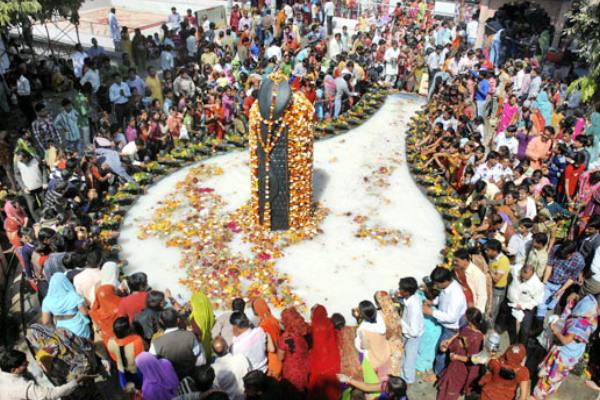

Navreh
Navreh, marking the Kashmiri Pandit New Year, is celebrated with great enthusiasm on the first day of the Chaitra (spring) month in the Hindu lunar calendar. Devotees visit temples to offer prayers for a prosperous new year, preparing special feasts and placing traditional items like rice, salt, and flowers in a thali (plate) as offerings. Navreh is not only a time for religious observance but also a celebration of Kashmiri culture, with families coming together to celebrate their heritage and reinforce their cultural bonds.
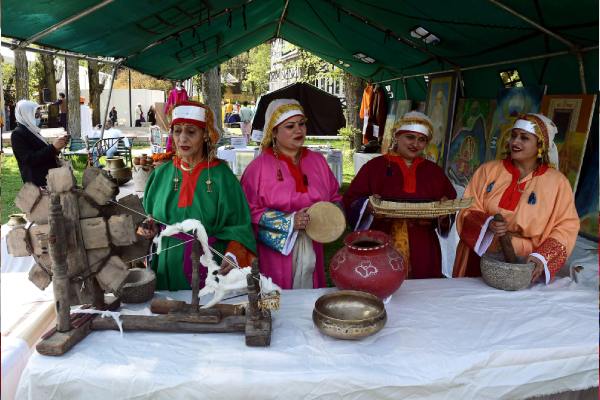
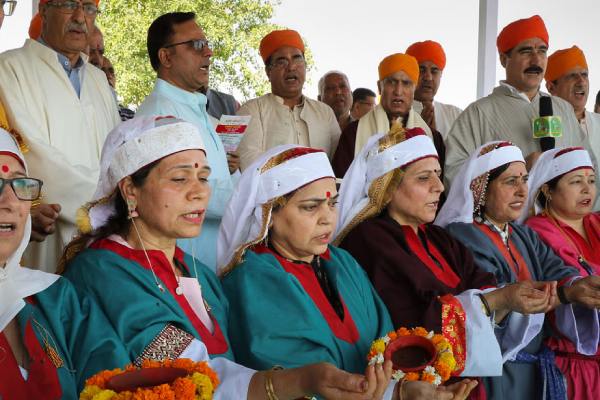
Check now : Kashmir Budget Tour Packages
Visit Kashmir with our exclusive : Kashmir Tour packages from Mumbai
Visit Kashmir with our exclusive : Kashmir Tour packages from Mumbai
Zyeshta Ashtami
Celebrated on the eighth day of the bright half of the month of Jyeshta, this festival is dedicated to Goddess Raganyadevi. Devotees visit the Khir Bhawani temple to offer prayers and seek the goddess’s blessings, where the temple’s fountains—believed to change colors depending on the goddess’ mood—form the center of rituals The festival is a time of spiritual contemplation and devotion, how devotees perform rituals in honor of the goddess.Jyeshtha Purnima
Celebrated on the full moon day of the month of Jyeshta, Jyeshta Purnima is an important event for Kashmiri Pandits, especially women. It is marked by prayers and special devotional rituals. On this day, devotees go to the temple to offer prayers, perform rituals like bathing for the gods, and prepare special food as offerings. Celebrating their commitment to religious practices and cultural heritage, the festival highlights the important role women play in maintaining and preserving religious traditions.
Visit Kashmir in December for breathtaking winter landscapes—plan your trip now!
Don’t miss the Zyeshta Ashtami festival at Kheer Bhawani. It’s a sea of traditional Kashmiri attire and the sound of bells ringing. The atmosphere is electric as people seek blessings and enjoy cultural programs.
Daily Worship:
But it’s not just about big festivals. Daily rituals keep the spiritual flame burning. Early morning aarti at the Shankaracharya Temple is a peaceful start to the day. Devotees climb the steps, often barefoot, to offer prayers as the sun rises over the valley. Throughout the day, you’ll see people performing puja, offering flowers, and lighting diyas. The chanting of mantras creates a soothing backdrop. Many Kashmiri Pandits, even those living far from Kashmir, maintain these practices at home altars.
In the evening, the temples glow with lamps as priests perform the soothing Sandhya aarti. It’s a moment of reflection and gratitude, ending the day on a spiritual note.
These rituals aren’t just religious acts – they’re threads connecting Kashmiri Pandits to their heritage. Each prayer and festival is a living piece of history, keeping ancient traditions alive in modern times.
These rituals aren’t just religious acts – they’re threads connecting Kashmiri Pandits to their heritage. Each prayer and festival is a living piece of history, keeping ancient traditions alive in modern times.
The Cultural and Religious Significance of Kashmiri Temples for the Kashmiri Pandit Community
Kashmiri temples are more than simply historical structures; they are colourful symbols of the Kashmiri Pandit community’s cultural and non secular identification. These sacred websites maintain deep religious meaning and play a critical function in keeping and celebrating the wealthy heritage of the region. In this article, we explore the cultural and spiritual significance of those temples, highlighting their significance to the Kashmiri Pandit community.


Cultural Significance of Kashmiri Temples
Preservation of Heritage:
Kashmiri temples are important custodians of the area’s rich cultural and historical past, preserving the historic customs, traditional arts, craftsmanship and architectural styles that mark the historical continuity of Kashmiri Pandit culture at birth series, reflecting the theoretical and architectural developments of earlier periods. These sacred spaces are living monuments, providing a tangible link to the site’s records and acting as guardians of its enduring traditionsSocial and Community Hub:
A temple is central to the celebration of major festivals and civic gatherings, providing a place for the Kashmiri Pandit community to come together, celebrate and strengthen their cultural ties In addition to religious ceremony cultural events, educational programs and communities are held there activities to foster a sense of solidarity and community membership performing a dual role as a vibrant cultural and civic center highlights the importance of mosques.Architectural Heritage :
Kashmiri temples are known for their distinctive architectural style, with intricate carvings, stonework and fine paintings showing the detailed craftsmanship of ancient architects These paintings contain symbols and motifs important to the Kashmiri Pandit tradition, and it reinforces their cultural and religious values.

Religious Significance of Kashmiri Temples
-
Spiritual Sanctuaries :
Kashmiri temples are important custodians of the area’s rich cultural and historical past, preserving the historic customs, traditional arts, craftsmanship and architectural styles that mark the historical continuity of Kashmiri Pandit culture at birth series, reflecting the theoretical and architectural developments of earlier periods. These sacred spaces are living monuments, providing a tangible link to the site’s records and acting as guardians of its enduring traditions -
Religious Practices and Rituals
A temple is central to the celebration of major festivals and civic gatherings, providing a place for the Kashmiri Pandit community to come together, celebrate and strengthen their cultural ties In addition to religious ceremony cultural events, educational programs and communities are held there activities to foster a sense of solidarity and community membership performing a dual role as a vibrant cultural and civic center highlights the importance of mosques. -
Preservation of Religious Traditions :
Kashmiri temples are known for their distinctive architectural style, with intricate carvings, stonework and fine paintings showing the detailed craftsmanship of ancient architects These paintings contain symbols and motifs important to the Kashmiri Pandit tradition, and it reinforces their cultural and religious values.
Conclusion
The Shankaracharya Temple, dedicated to Lord Shiva, is the most revered Hindu temple for Kashmiri Pandits. Located on the Shankaracharya Hill in Srinagar, Jammu and Kashmir, this ancient temple is a symbol of their rich cultural heritage and spiritual devotion. Its historical significance and religious importance make it a central pilgrimage site, where Kashmiri Pandits seek blessings and connect with their ancestral roots. The temple’s serene ambiance and panoramic views of the valley enhance its sacredness, solidifying its place as a cornerstone of faith for the Kashmiri Pandit community.Related Blogs
March 12, 2025Kashmir Hills
Sustainable Eco-Friendly & Responsible Tourism in Kashmir
Spread the loveKashmir, often referred to as
November 29, 2024Kashmir Hills
Kashmir tour for Schools, Colleges and Education institutions
Spread the loveKashmir, often known as “Paradise
November 16, 2024Kashmir Hills
Meetings, Incentives, Conferences, and Exhibitions Tours in Kashmir – MICE Tourism
Spread the loveMICE tourism (meetings, incentives, conferences,
October 7, 2024Kashmir Hills
Pre Wedding Photography in Kashmir
Spread the loveKashmir, often called the “Heaven
September 21, 2024Kashmir Hills
Romantic idea to make your honeymoon memorable in Kashmir
Spread the loveAre you dreaming of a
September 18, 2024Kashmir Hills
Destination Wedding in Kashmir
Spread the lovePlanning a wedding in Kashmir
August 21, 2024Kashmir Hills
Low Cost Kashmir Budget Friendly Tour
Spread the loveKashmir has truly breathtaking places
August 12, 2024Kashmir Hills
Most Popular Shopping Markets in Sonamarg
Spread the loveThe Sonmarg Market is a
August 12, 2024Kashmir Hills
Adventure Activities & Things to Do in Doodhpathri
Spread the loveLocated in the scenic landscapes
August 12, 2024Kashmir Hills
Sightseeing in Doodhpathri
Spread the loveLocated in the serene landscape










